Our Health Philosophy
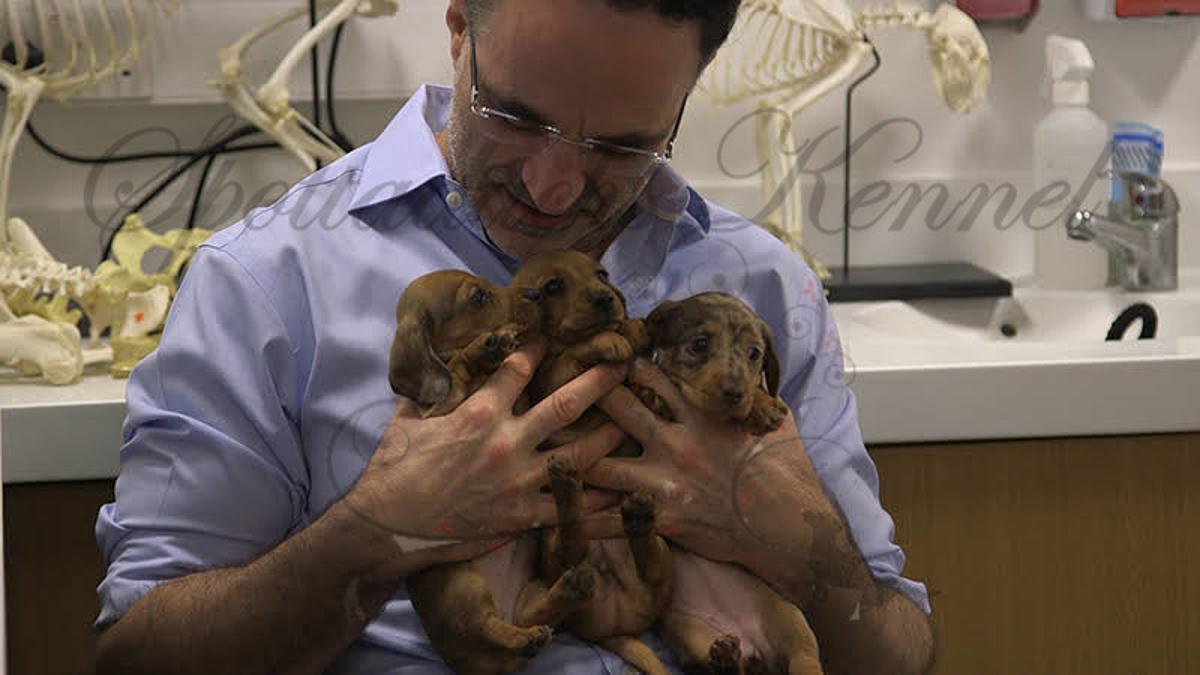
At Spottadachs we believe in breeding to better the breed. The majority of all income we receive from raising puppies goes to bettering our program, genetics, and the lives of our adults. This includes but is not limited to high-quality food, health care, genetic testing, enrichment, and customer care in the form of starter packs, and lifetime support.
All of our dogs are genetically tested through Embark on over 230,000 genetic markers for 250+ genetic variants associated with canine disease, as well as 35+ physical traits, including coat colors, length, shedding, adult size, and more. Embark’s stringent quality control ensures >99% accuracy for mutation tests and most linkage-based tests.
Breeding
Our dogs (males and females) receive the best of care starting long before they even become parents. Each one is health tested, and evaluated individually for their mental and physical readiness. We strongly believe a healthy diet and lots of regular exercise make healthier puppies and easier birthing. Being raised in a pack to learn proper social behaviors and body language in turn makes for less stressful couplings.
Occasionally we have a female whose stomach grows so large her legs barely reach the ground and mobility becomes an issue. We like to call these short dog problems.
For these mama’s we do daily aqua-therapy (AKA: time in the bathtub or swimming pool) to keep those muscles supple.
A week before the due date, we start customizing the mama to her private birthing area.
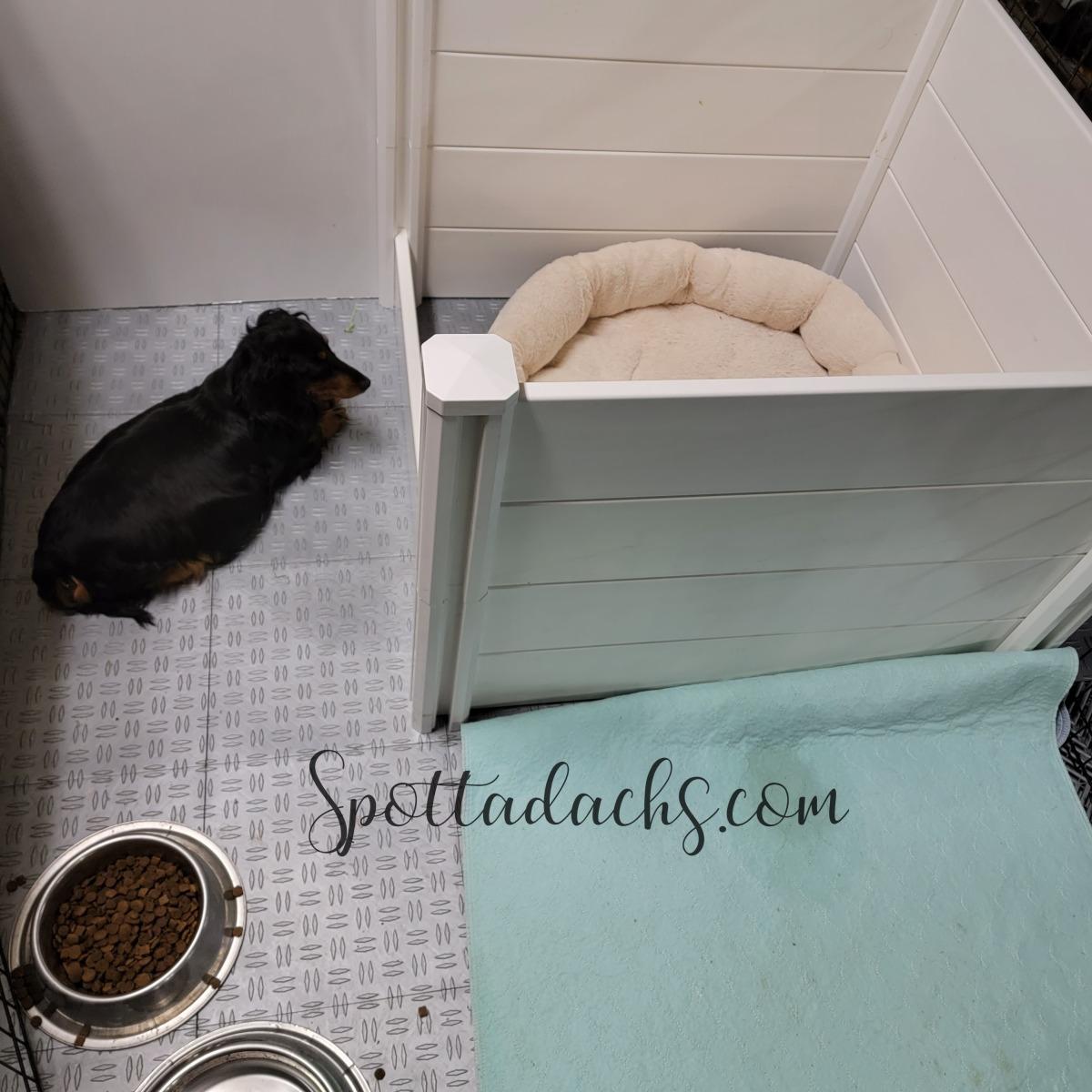
Three days before the due date we begin taking daily temperatures, as they will drop, and then spike to let us know the time will be soon.
On the day of birthing (which may or may not be on the due date), we closely monitor the mama, who usually has begun franticly digging at her bedding.
Once puppies start arriving, they are dried, weighed, and put at the mother’s nipple to ensure they receive colostrum.
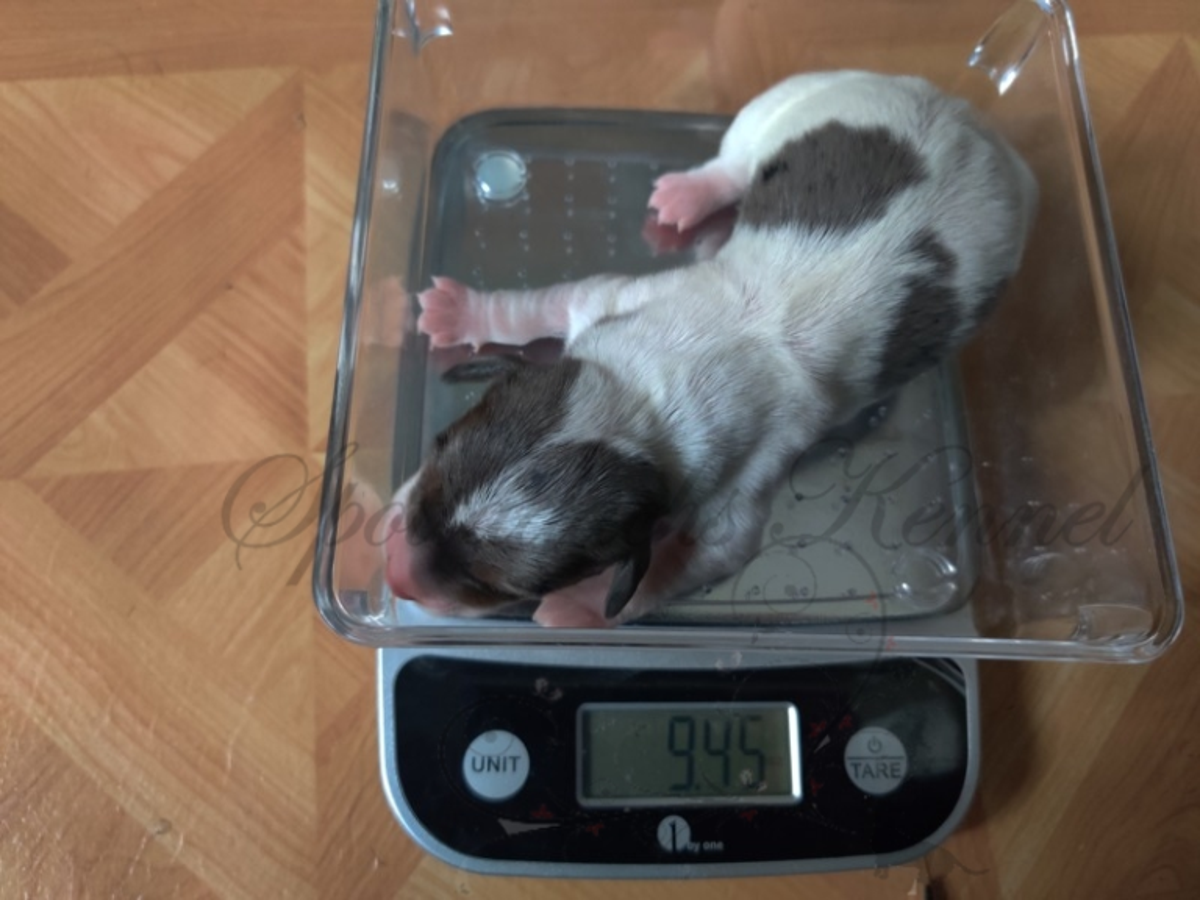
We have a fully equipped birthing kit on hand, including a puppy-sized oxygen mask and a special “NICU” box for pups that are struggling or need extra supervision for a bit.
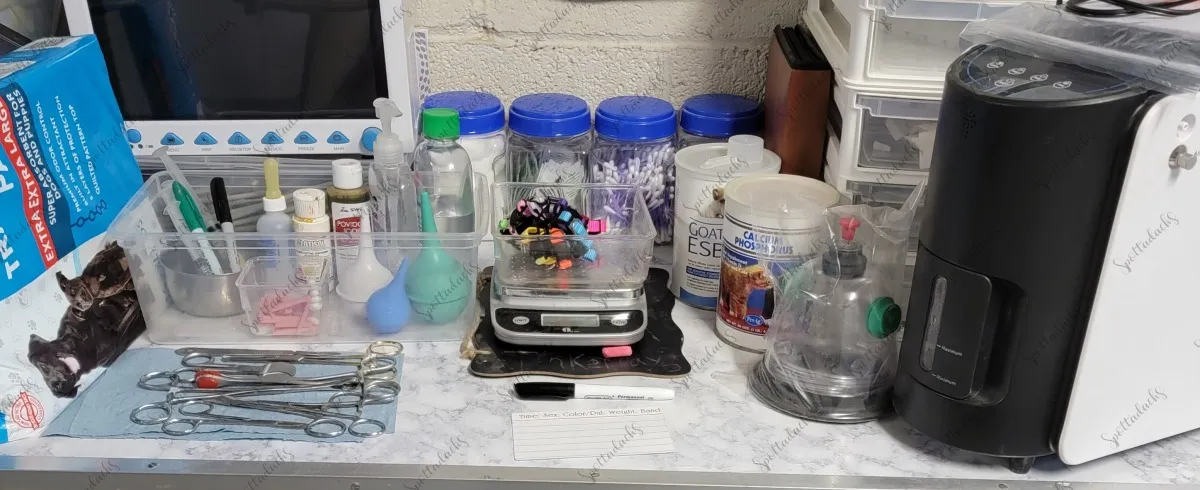
Dew Claws
There are two types of dewclaws, which dogs use for handling larger objects like bones, and in some breeds for changing direction when running. The first is an ‘articulated’ dewclaw, meaning the claw is attached to the leg by joints and tendons. The second is a ‘non-articulated’ dewclaw, which is attached by a flap of skin and some tissue, requiring less involvement to remove. Front dewclaws are usually articulated, while secondary or rear dewclaws are generally non-articulated.
We used to remove all of our dog’s dew claws at the age of 3 days because that is what is required for showing and I grew up thinking it was the cleaner more correct way to do things. However, after extensive research and discussion with multiple vets, I have come to realize the difference between a healthy useful dewclaw and an improper one. Any pups that are born with a second or rear dewclaw will still have it removed as these types are improperly connected and apt to be accidentally torn off.
Here is a description from a licensed vet on the matter.
M. Christine Zink DVM, PhD, DACVSMR
“I am a vet that works exclusively with performance dogs, developing rehabilitation programs for injured dogs or dogs that have had surgery as a result of performance-related
injuries. I have seen many dogs now, especially field trial/hunt test and agility dogs, that have had chronic carpal arthritis, frequently so severe that they have to be retired or at least carefully managed for the rest of their careers. Of the over 30 dogs I have seen with carpal arthritis, only one has had dewclaws. The others have all had them removed.
If you look at an anatomy book (Miller’s Guide to the Anatomy of Dogs is an excellent one – see figure below) you will see that there are 5 tendons attached to the dewclaw. Of course, at the other end of a tendon is a muscle, and that means that if you cut off the dewclaws, there are 5 muscle bundles that will become atrophied from disuse.
Those muscles indicate that the dewclaws have a function. That function is to prevent torque on the leg. Each time the foot lands on the ground, particularly when the dog is cantering or galloping, the dewclaw is in touch with the ground. If the dog then needs to turn, the dewclaw digs into the ground to support the lower leg and prevent torque. If the dog doesn’t have a dewclaw, the leg twists. A lifetime of that and the result can be carpal arthritis. Remember: the dog is doing the activity regardless, and the pressures on the leg have to go somewhere.
They can be absorbed by the dewclaw, or they will move up and down the leg to the toes, carpus, elbow, and shoulders.
Perhaps you are thinking, “I never have had one of my dogs have carpal pain or arthritis.” Well, we need to remember that dogs, by their very nature, do not tell us about mild to moderate pain. If a dog was to be asked by an emergency room nurse to give the level of his pain on a scale from 0 to 10, with 10 being the worst, their scale would be 0, 0, 0, 0, 0, 6, 7, 8, 9, 10. Most of our dogs, especially if they deal with pain that is of gradual onset, just deal with it and don’t complain unless it is excruciating. But when I palpate the carpal joints of older dogs without dewclaws, I almost always elicit pain with relatively minimal manipulation.
As to the possibility of injuries to dewclaws. Most veterinarians will say that such injuries actually are not very common at all. And if they do occur, then they are dealt with like any other injury. In my opinion, it is far better to deal with an injury than to cut the dewclaws off of all dogs “just in case.”
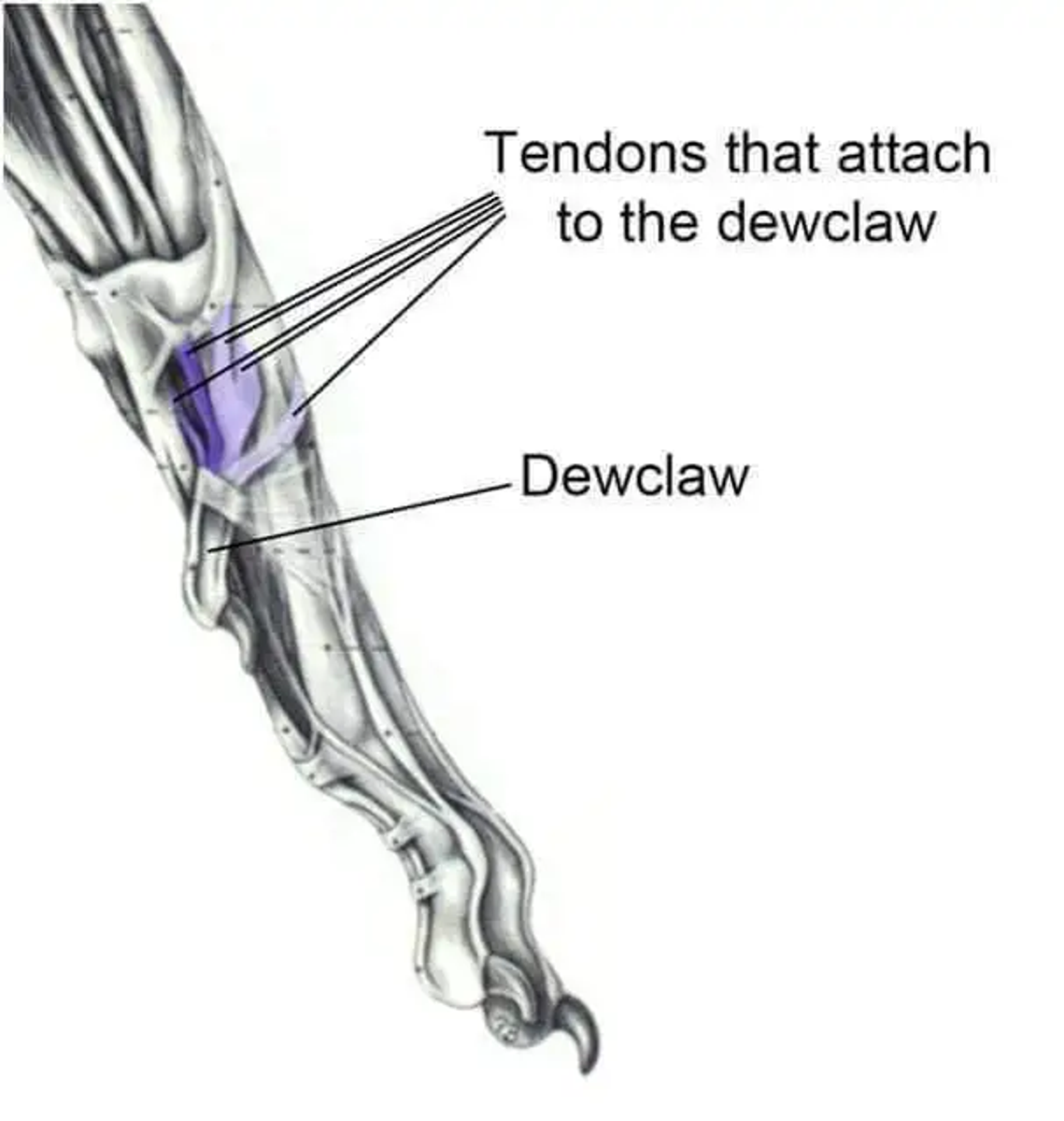
Anatomical diagram viewing the medial side of a dog’s left front leg demonstrating the five tendons that attach to the dewclaw.”
Buyers may request all dew claws removed if they desire but it must be before 5 days old.
What difference will, not having dew claws removed mean for you as a dog owner? The only difference is that you will need to be more mindful of your dog’s nail trims. Dewclaws tend to curve and get thicker faster than normal nails because they are not shortened by walking on hard surfaces like dirt or concrete. Dogs that are on carpets or soft surfaces the majority of the time will need all of their nails trimmed more often.
Vaccinations
At the beginning of our breeding program, we were not as vigilant about vaccinations as we are now. We have been extremely lucky to learn some hard lessons from watching our friends and other breeders go through tragedy in their kennels.
Some people might say we are overly vaccinating our dogs, BUT with 20+ years of experience as well as tons of research and talking to other larger breeders who experience things at a much faster rate we have come to the system we use now for specific reasons.
The following is the basic timeline we vaccinate our dogs with:
5-6 weeks old – NeoPar (A modified live virus, highly immunogenic strain of canine parvovirus)
7-8 weeks – Canine Spectra 6 way (Distemper, Adenovirus Type 1, Adenovirus Type 2, Parainfluenza, Parvovirus, Coronavirus)
We have chosen this regimen due to the lighter distribution of vaccines rather than all together as in the 5-7 way which we feel often overwhelms the younger puppies. After 7 weeks their bodies are more equipped to handle a multi-vaccine. We also feel the modified live which overrides maternal antibodies in a single dose gives much better protection than repeated hopes that the killed vaccine will cover until their body is ready to accept it.
NeoPar has enabled us to safely place pups in homes or areas that may have been compromised with Parvo Virus in the past with amazing success.
If still with us after 8 weeks & suggested regimen for you to continue:
9, 12 & 15 weeks – 5-7 way according to local concerns and as recommended by your vet. Please note: Dachshunds tend to have adverse reactions to the Leptospirosis vaccine. It is highly recommended you discuss this with your vet. We do not give our own pups the Lepto vaccine until after 12 weeks old as well as give them a dose of Benadryl beforehand to help with possible reactions.
14-16 weeks is generally when mom’s immunity is gone and pups begin to produce their own this age group has the highest rate of parvo infection. We always highly suggest not taking your pup to public places like Petco or dog parks until after 16 weeks.
See a sample of the health record we provide
De-Worming
De-worming of our puppies begins two weeks before they are even born when the mom is de-wormed.
After birth pups are de-wormed beginning at 2 weeks and continuing every 2 weeks until they go to their new homes because puppies will be puppies and eat everything.
As part of our social training, our pups are exposed to all sorts of wonderful germs such as chickens, cats, and other farm animals.
Pups are given a dewormer right before leaving for their new homes where stress like leaving mom and going to a whole new lifestyle can activate dormant eggs deep in the muscles/tissues that normal worming can not reach. You may be instructed to continue dosing for an additional couple of days if we feel extra protection is needed.
Microchips
We have carefully evaluated both sides of the subject of micro-chipping our puppies and dogs. I will be honest, for many years I was against micro-chipping because I fell for some of the “old wives’ tails” like microchips cause cancer. Perhaps in the early days, before generations and generations of advancement and improvement in science, this was a higher case.
I did in Great Danes see some migration cases which I now understand were a combination of improper insertion and the huge amount of loose skin that adjusts as a giant breed puppy grows.
I have had NO cases of Cancer or migration with my miniature dachshunds.
The benefits outweigh any risks in my mind.
Some of the benefits of micro-chipping our puppies are that we and/or you, as the owner, are notified if the puppy/dog ever ends up in a rescue or animal control facility.
If your puppy is ever stolen (and this has happened), a microchip provides proof of identity, thus aiding in a much quicker return to you.
Our policy on microchips is that all pups are microchipped at around 7.5 weeks. We register the microchip in our account. The buyer’s contact information will be added as the first contact; however, the registration will remain in our account, so if the owner is not able to be contacted, we will be notified as secondary.
It is the buyer’s responsibility to keep us updated on changes in contact information so we can keep the microchip current as well.